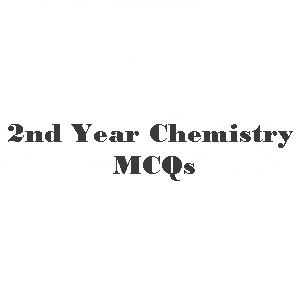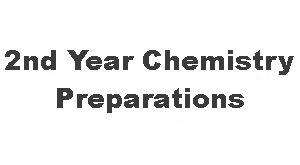If you are going to prepare for the Entry Test and searching for Chemistry 2nd Year Fundamental Principles of Organic Chemistry Mcqs, then you can get the important MCQs on this page. This chapter is about Organic Chemistry. Before 1828, it was thought that Organic Compounds can’t be manufactured by an inorganic material. But this theory was rejected by Friedrick Wohler. Organic compounds are those which contain carbon, hydrogen, and their derivatives. They have many salient features. They have much importance in our daily life. The sources of Organic compounds include Coal, Natural Gas, and Petroleum. Cracking and Reforming of Petroleum is done to increase its octane number. Organic compounds are classified into Open chain and Closed Chain compounds. Their shapes are defined through Hybridization. Isomerism is an important term that represents formulas of different organic compounds. So, have a look at this page to get the important MCQs of this chapter.
Chemistry 2nd Year Fundamental Principles of Organic Chemistry Mcqs

KEY POINTS
- Organic Compounds/features/importance
- Sources of Organic Compounds
- Cracking and Reforming of Petroleum
- Classification of Organic Compounds
- Hybridization of Organic Compounds
- Isomerism
Question#1: The phenomenon of cracking is also referred to as:
- Bond fusion
- Bond fission
- Bond condensation
- None of these
Answer
Answer
Question#2: While selecting the longest possible chains among the organic compounds for nomenclature, when two or more chins complete each other, which one is selected:
- Chins with less substituent
- Chin with a greater number of substituent
- Chine near to double bond
- Chins near to triple bond
Answer
Answer
Question#3: When a double bond and a triple bond complete each other in a single chain the preference of giving a number I carbon will be given to:
- Double bond
- Triple bond
- Equally preferred
- None of these
Answer
Answer
Double bond
Question#4: The isomerism in which the compounds differ with respect to the same functional group but have the same molecular formula is called______.
- Metamerism
- Functional group isomerism
- Position isomerism
- Chain isomerism
Answer
Answer
Question#5: Which type of isomerism is exhibited by the following compounds:
CH3-O-CH3-and CH3CH2OH
- Chain isomerism
- Functional group isomerism
- Position isomerism
- Metamerism
Answer
Answer
Question#6: Which type of isomerism is shown by the following compounds:
CH3CH2-0- CH2 CH3 and CH3 CH2 CH2-OCH3
- Chain isomerism
- Functional group isomerism
- Position isomerism
- Metamerism
Answer
Answer
Question#7: Chain isomerism is also called:
- Metamerism
- Skeletal isomerism
- Tautomerism
- All of these
Answer
Answer
Question#8: Which of the following best describes the similarities and the differences of compounds which are isomers?
- Same chemical properties but different molecular formulae
- Same physical properties but different chemical properties
- Same molecular formulae but different structures
- Same structure but different molecular mass
Answer
Answer
Question#9: Which statement about the members of a homologous series is correct:
- They have the same empirical formula
- They have the same melting points
- They have the same number of carbon atoms per molecule
- They undergo similar reactions
Answer
Answer
Question#10: The four structural diagrams of organic compounds are shown:
I- CH3-OH and II- CH3 and III- CH3-O- CH3 –and IV- CH3-CH2-OH
Which are the two members of the same homologous series?
- 1st and 2nd
- 1st and 3rd
- 1st and 4th
- 2nd and 3rd
Answer
Answer
Question#11: The structures of the three compounds are shown:
I- CH3 CH2 –O- CH3 and II- CH3 CH2 CH2 -OH and III- CH3 CH (OH) CH3
- 1st and 2nd only
- 2nd and 3rd only
- 1st and 3rd only
- All are isomers of one another
Answer
Answer
Question#12: The compounds having the same structural formula but differ with respect to the positions of the identical group in space are said to exhibit:
- Skeletal isomerism
- Cis-trans isomerism
- Geometric isomerism
- Both b and c
Answer
Answer
Question#13: Similar group lies on the same side of the functional group:
- Cis form
- Trans form
- Cis transform
- None of these
Answer
Answer
Question#14: Ether shows the phenomenon of :
- Position isomerism
- Functional group isomerism
- Metamerism
- Cis trans isomerism
Answer
Answer
Question#15: Diethyl ketone and Methyl n- propyl compounds?
- Metameric isomerism
- Cis trans isomers
- Positional isomers
- None of these
Answer
Answer
Question#16: Which one is the property of organic compounds?
- Catenation
- Low melting and boiling point
- Complexity in isomers
- All of these
Answer
Answer
Question#17: The formula of 2-chloro-2-methylpropane is?
- (CH3)2CH-CI
- (CH3)3 C-CI
- CH3)2 C(CI)2
- CH3 –( CH2)3-CI
Answer
Answer
Question#18: Which of the following compound is not heterocyclic?
- Pyridine
- Phenol
- Thiophene
- Pyrrole
Answer
Answer
Question#19: Which of the following structures will not display geometrical isomerism?
- CH3 -CBR=CBR CH3
- CH3 CH=CHCI
- CH3 -CH=CH- CH3
- CH3-CH=CBr2
Answer
Answer
Question#20: Which one of the following is alicyclic hydrocarbon?
- Benzene
- Cyclohexane
- Isobutylene
- Neopentane
Answer
Answer
Question#21: Which type of reactions are more abundant in organic reaction?
- Substitution reaction
- Addition reaction
- Free radical reaction
- Elimination reaction
Answer
Answer
Question#22: Which compound has only one structural form?
- Ethane
- Butane
- Propane
- Both a and b
Answer
Answer
Question#23: The reagent which attacks a region where the electron density is high is called:
- Nucleophile
- Electrophile
- Substrate
- None of these
Answer
Answer
Question#24: Which statement is incorrect about cis-trans isomerism?
- Two carbon atoms with the double bond cannot rotate freely
- Two compounds that possess the same structural formula but differ with respect to the positions of identical groups in space.
- In cis form, similar groups lie on the same side of a double bond
- Two groups attached to the same carbon must be the same.
Answer
Answer
Question#25: The zwitterion is an example of:
- Metamerism
- Tautomerism
- Functional group isomerism
- Positional isomerism
Answer
Answer
Question#26: The compounds which are optically active are called:
- Chiral
- A mirror image of one another
- Carbon with group isomerism
- All of these
Answer
Answer
Question#27: For the tetrahedral molecules the molecule is chiral if all fur substituents are:
- Same
- Different
- Opposite
- None of these
Answer
Answer
Question#28: Which one alcohol is aromatic?
- Glycerol
- 2-phenyl ethanol
- Ethane-1,2 diol
- None of these
Answer
Answer
Question#29: Which one is the name of a given compound by the IUPAC system of nomenclature?
CH2=CH-CH=CH2
- But-2-ene
- 2-methyl I-I-ene
- Buta -1 , 3 –diene
- 2,4 –butadiene
Answer
Answer
Question#30: Which one is not dicarboxylic acid?
- Phthalic acid
- Benzoic acid
- Adipic acid
- Oxalic acid
 Online Exams Tests Preparation
Online Exams Tests Preparation


